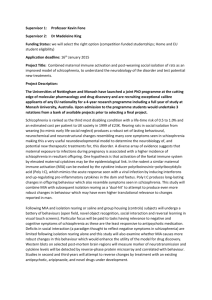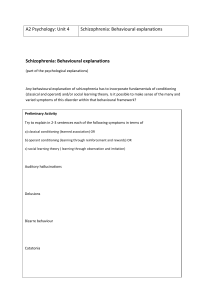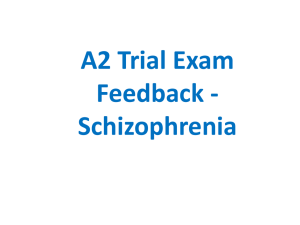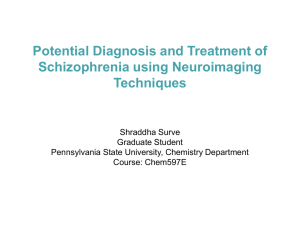Psychology and neuroscience (W)
advertisement
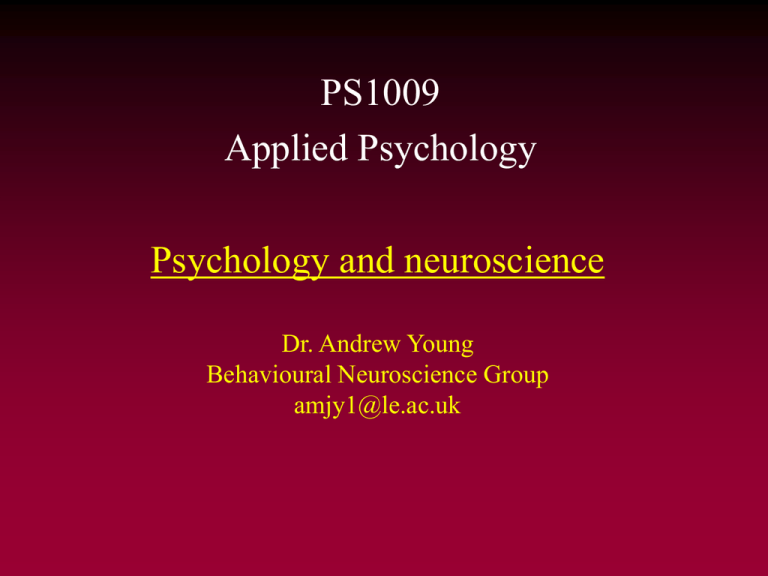
PS1009 Applied Psychology Psychology and neuroscience Dr. Andrew Young Behavioural Neuroscience Group amjy1@le.ac.uk Psychology and brain function PS1009 • As psychologists we study the interaction between an organism and its environment • Perceiving the environment (sensory perception) The Brain Integration Decision Transmission • Behavioural responses Neuronal connectivity Chemicals (Neurotransmitters) Neurones Electrical activity Brain function and behaviour PS1009 Paul Broca (c1860) • Studied a patient called ‘Leborgne’ • intelligent and capable of comprehending spoken and written language • but unable to speak more than a very few meaningless syllables for 21 years • capable of communication using motor gestures Post-mortem study of brain showed: • single lesion towards back of left frontal lobe • first evidence for highly localised control of function in the cortex Types of measurement PS1009 • Post-mortem studies • Provides anatomical information • Of limited value for functional studies • Living neurones in isolation (in vitro - e.g. cultures, slices) • Show how living neurones can function • But give limited information on behaviour • Studies intact brains • Effects of brain injury on behaviour • Effects of drugs with known pharmacology on behaviour • Monitoring brain activity during behaviour • Underpinned by post-mortem and in vitro studies Study of normal brain function PS1009 • • • • • • • • • Perception – vision, sight, smell, taste * Movement * Language • Neuronal systems involved – e.g. hippocampus * Learning and memory • Electrical process involved – e.g. LTP * • Neurotransmitters involved – e.g. glutamate * Sleep Pain and analgesia (* see PS1003 lectures) Mood Personality ….. many more Study of abnormal function PS1009 • Studying neuronal processes and/or neurotransmitters involved in • Perceptual disorders • Motor disorders • Schizophrenia • Depression • Anxiety • Parkinson’s disease • Ischaemia (stroke) • Epilepsy • Addiction • ….. many others Symptoms of psychosis PS1009 Abnormal ideas : • delusions (mood, persecution, grandiose, hypochondriacal) Abnormal perceptions : • hallucinations (mainly auditory) Formal thought disorder : • derailment, loss of goal, neologisms, poverty of speech content Motor, volition and behavioural disorder : • catatonia, abnormal posture, avolition, mutism, Emotional disorders : • affective flattening, emotional withdrawal, anhedonia. Difficult to measure objectively Can psychology help us understand schizophrenia? PS1009 Understanding biological basis of psychological function - relationship with dysfunction in psychiatric disease • effects of brain injury on behaviour • effects of drugs on behaviour • pharmacology of drugs with therapeutic effects • studies with tasks which rely certain brain areas • brain imaging studies, especially function in these tasks • use of animal models of psychological function Effects of brain injury on behaviour PS1009 • Temporal lobe dysfunction (e.g. temporal lobe epilepsy) • Can lead to some symptoms similar to positive symptoms of schizophrenia. • Frontal lobe damage (e.g.frontal lobectomy) • Leads to symptoms similar to negative symptoms of schizophrenia. Effects of drugs on behaviour PS1009 Several drugs known to cause symptoms similar to schizophrenia: • Amphetamine – causes hallucinations and delusions very similar to positive symptoms of schizophrenia • Are positive symptoms associated with increased dopamine? • LSD – causes hallucinations which are similar the positive symptoms of schizophrenia • Are positive symptoms associated with increased serotonin? Pharmacology of drugs with therapeutic effect PS1009 • Classical (‘typical’) antipsychotic drugs • Antagonists at dopamine receptors • Newer (‘atypical’) antipsychotic drugs • Antagonists at both dopamine and serotonin receptors Dopamine and serotonin over-activity both implicated in schizophrenia. Studies using tasks relying on certain brain areas PS1009 • Positively symptomatic schizophrenics are deficient in tasks requiring temporal lobe function • e.g. selective attention – latent inhibition (learning to ignore irrelevant stimuli) • Schizophrenics are deficient in tasks requiring frontal lobe function • e.g. Wisconsin card sort, Tower of Hanoi • First degree relatives of schizophrenics are also deficient in frontal lobe tasks. Brain imaging studies PS1009 • Functional magnetic resonance imaging (fMRI) studies have looked at brain areas activated during these tasks: • e.g. Latent inhibition -2 Z-coordinate of slice 4 9 Right Left Young AMJ et al., 2005 • How does this differ in schizophrenic patients? Animal models of psychological function PS1009 Latent inhibition in animals – relationship with schizophrenia Learning SALINE AMPH AMPH +HAL Schizophrenia Poor LI Good NON-PREEXPOSED PREEXPOSED Latent inhibition provides a model for studying the neural basis of schizophrenia Information processing deficits in schizophrenia PS1009 Kraepelin (1913) "Schizophrenic patients are unable to exclude irrelevant sensory information from their awareness" McGhie & Chapman (1961) Pateint A : "I can't shut things out" Patient B : "I let all the sounds come in that are there" Patient C : "I'm attending to everything at once, so I don't really attend to anything" These may be indicative of deficits in sensory gating (e.g. selective attention). Psychology and neuroscience PS1009 • Understanding the neural and neurochemical basis of psychological function in the normal brain • Perception • Intrinsic processing • Motor output • ‘Behaviour’ • Studying the neural and neurochemical basis of behaviour gives us insights into dysfunctions underlying psychiatric disease.

